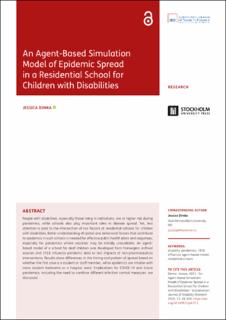| dc.contributor.author | Dimka, Jessica | |
| dc.date.accessioned | 2023-02-21T10:21:25Z | |
| dc.date.available | 2023-02-21T10:21:25Z | |
| dc.date.created | 2023-01-12T10:18:40Z | |
| dc.date.issued | 2023-01-11 | |
| dc.identifier.issn | 1745-3011 | |
| dc.identifier.uri | https://hdl.handle.net/11250/3052681 | |
| dc.description.abstract | People with disabilities, especially those living in institutions, are at higher risk during pandemics, while schools also play important roles in disease spread. Yet, less attention is paid to the intersection of risk factors at residential schools for children with disabilities. Better understanding of spatial and behavioral factors that contribute to epidemics in such schools is needed for effective public health plans and responses, especially for pandemics where vaccines may be initially unavailable. An agent-based model of a school for deaf children was developed from Norwegian archival sources and 1918 influenza pandemic data to test impacts of non-pharmaceutical interventions. Results show differences in the timing and pattern of spread based on whether the first case is a student or staff member, while epidemics are smaller with more student bedrooms or a hospital ward. Implications for COVID-19 and future pandemics, including the need to combine different infection control measures, are discussed. | en_US |
| dc.language.iso | eng | en_US |
| dc.publisher | Stockholm University Press | en_US |
| dc.relation.ispartofseries | Scandinavian Journal of Disability Research;Volume 25 - Issue 1 | |
| dc.rights | Navngivelse 4.0 Internasjonal | * |
| dc.rights.uri | http://creativecommons.org/licenses/by/4.0/deed.no | * |
| dc.title | An Agent-Based Simulation Model of Epidemic Spread in a Residential School for Children with Disabilities. | en_US |
| dc.type | Peer reviewed | en_US |
| dc.type | Journal article | en_US |
| dc.description.version | publishedVersion | en_US |
| dc.rights.holder | © 2023 The Author(s) | en_US |
| cristin.ispublished | true | |
| cristin.fulltext | original | |
| cristin.qualitycode | 1 | |
| dc.identifier.doi | http://doi.org/10.16993/sjdr.933 | |
| dc.identifier.cristin | 2105553 | |
| dc.source.journal | Scandinavian Journal of Disability Research | en_US |
| dc.source.volume | 25 | en_US |
| dc.source.issue | 1 | en_US |
| dc.source.pagenumber | 15-28 | en_US |
| dc.relation.project | EC/H2020/841925 | en_US |

